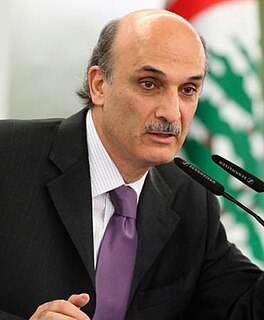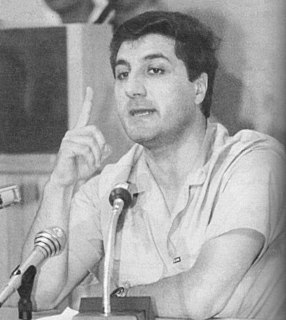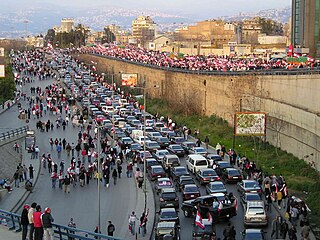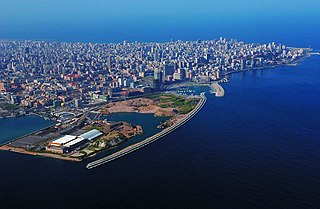
Samir Farid Geagea is a Lebanese militia leader and politician. He is also the executive chairman of the Lebanese Forces, a Christian political party in Lebanon.

The Guardians of the Cedars (GoC) are a far-right ultranationalist Lebanese party and former Christian militia in Lebanon. It was formed by Étienne Saqr and others along with the Lebanese Renewal Party in the early 1970s. It operated in the Lebanese Civil War under the slogan: Lebanon, at your service.
The Hundred Days War, also known as 'La Guerre des Cent Jours' in French was a subconflict within the 1977–82 phase of the Lebanese Civil War which occurred at the Lebanese Capital Beirut. It was fought between the allied Christian Lebanese Front militias, under the command of the Kataeb Party's President Bachir Gemayel, and the Syrian troops of the Arab Deterrent Force (ADF).

The Lebanese Forces is a Lebanese Christian based political party and former militia during the Lebanese Civil War. It currently holds fifteen of the 64 Christian seats in Lebanon's parliament and is therefore the second largest Christian party in parliament

Operation Grapes of Wrath is the Israeli Defense Forces code-name for a sixteen-day campaign against Lebanon in 1996 which attempted to end rocket attacks on Northern Israel by Hezbollah. Israel conducted more than 1,100 air raids and extensive shelling. A UN Interim Force compound at Qana was hit when Israeli artillery fired on Hezbollah forces operating nearby. 639 Hezbollah cross-border rocket attacks targeted northern Israel, particularly the town of Kiryat Shemona. Hezbollah forces also participated in numerous engagements with Israeli and South Lebanon Army forces. The conflict was de-escalated on 27 April by a ceasefire agreement banning attacks on civilians.
On July 25, 1993, Israeli forces launched a week-long attack against Lebanon named Operation Accountability in Israel and the Seven-Day War in Lebanon. Israel specified three purposes to the operation, to strike directly at Hezbollah, to make it difficult for Hezbollah to use southern Lebanon as a base for striking Israel, and to displace refugees in the hopes of pressuring the Lebanese government to intervene against Hezbollah. The affected civilian population included both Lebanese and Palestinian refugees.

Souk El Gharb, also spelled Suk, Sug al, ul, Suq), is a town located in the Aley District, Mount Lebanon Governorate, in Lebanon and its name translates to "Western Market".
The Lebanese Forces – Executive Command or LFEC, was a splinter group from the Lebanese Forces led by Elie Hobeika, based in the town of Zahlé in the Beqaa valley in the late 1980s. It was initially founded in January 1986 under the title Lebanese Forces – Uprising or LFU, but later changed its designation.
Dahr al-Wahsh is a village in Lebanon, located 12 kilometres (7.5 mi) to the east of Beirut. Dahr al-Wahsh land is divided between the city of Aley and the towns of Kahale and Araya. It has received attention as the site of an October, 1990 conflict termed the "Dahr al-Wahsh massacre" by Middle-East studies professor Mordechai Nisan. Interpretation and description of the event varies according to source.

Bachir Gemayel, also Bashir Gemayel was a senior member of the right-wing Christian Phalange party and the founder and supreme commander of the Lebanese Forces militia during the early years of the Lebanese Civil War (1975–90). He was the youngest president-elect and one of the most controversial figures in Lebanese history.
The Zgharta Liberation Army or Zghartawi Liberation Army – ZLA was the paramilitary branch of the Lebanese Marada Movement during the Lebanese Civil War. The militia was formed in 1967 on President Suleiman Frangieh's instructions as the Marada Brigade seven years before the war began. The force was initially commanded by Suleiman Franjieh's son, Tony Frangieh. It operated mainly out of Tripoli and Zgharta, but it also fought in Beirut. The ZLA fought against various Palestinian and Lebanese Muslim militias as well as the Lebanese Forces in Bsharri and Ehden.
The 8th Infantry Brigade (Lebanon) is a Lebanese Army unit that fought in the Lebanese Civil War, being active since its creation in January 1983.
The Mountain War, also known as the War of the Mountain and Guerre de la Montagne in French, was a subconflict between the 1982–83 phase of the Lebanese Civil War and the 1984–89 phase of the Lebanese Civil War, which occurred at the mountainous Chouf District located south-east of the Lebanese Capital Beirut. It pitted the Christian Lebanese Forces militia (LF) and the official Lebanese Armed Forces (LAF) against a coalition of anti-government Muslim leftist militias led by the Druze Progressive Socialist Party (PSP), backed by the Palestine Liberation Organization (PLO) and Syria. Hostilities began when the LF and the LAF entered the predominantly Druze Chouf district to bring back the region under government control, only to be met with fierce resistance from local Druze militias and their allies. The PSP leader Walid Jumblatt's persistence to join the central government and his instigation of a wider opposition faction led to disintegration of the already fragile LAF and the eventual collapse of the government under President Amin Gemayel.

The Palestinian insurgency in South Lebanon was a conflict initiated by Palestinian militants based in South Lebanon upon Israel since 1968 and upon Christian Lebanese factions since mid-1970s, which evolved into the wider Lebanese Civil War in 1975 and lasted until the expulsion of the Palestinian Liberation Organization from Lebanon in the 1982 Lebanon War. Though the PFLP-GC and some other Palestinian factions continued a low-level military activities on Lebanese soil, after 1982 the conflict is considered to have faded in favor of local inter-Lebanese Mountain War and the Israel–Hezbollah conflict. The South Lebanon Palestinian insurgency, which peaked through the 1970s, claimed thousands of Israeli, Lebanese and Palestinian military and civilian lives, and is considered among the key elements to start the Lebanese Civil War.

The Lebanese Forces – LF or Forces Libanaises (FL) in French, was one of the main Christian factions of the Lebanese Civil War. Originally an umbrella organization for different Christian parties, the Lebanese Forces later became a separate organization. It was mainly staffed by Maronite Christians.
The Hama and Homs offensive during the Syrian Civil War was launched by the Islamic State of Iraq and the Levant (ISIL) in an attempt to cut the government supply line between its troops in central and northern Syria.

The People's Liberation Army – PLA or Armée de Libération Populaire (ALP) in French was the military wing of the left-wing Druze Progressive Socialist Party (PSP), which fought in the Lebanese Civil War. The PSP and its militia were members of the Lebanese National Movement (LNM) from 1975 to 1982.


















